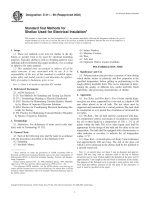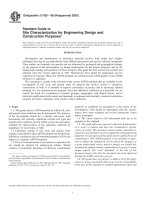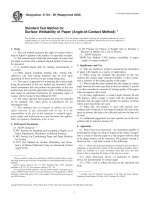Astm d 724 99 (2003)
Bạn đang xem bản rút gọn của tài liệu. Xem và tải ngay bản đầy đủ của tài liệu tại đây (44.74 KB, 4 trang )
Designation: D 724 – 99 (Reapproved 2003)
An American National Standard
Standard Test Method for
Surface Wettability of Paper (Angle-of-Contact Method)
1
This standard is issued under the fixed designation D 724; the number immediately following the designation indicates the year of
original adoption or, in the case of revision, the year of last revision. A number in parentheses indicates the year of last reapproval. A
superscript epsilon (e) indicates an editorial change since the last revision or reapproval.
E 122 Practice for Choice of Sample Size to Estimate a
Measure of Quality for a Lot or Process
2.2 TAPPI Standard:
TAPPI Test Method T 458 Surface wettability of paper
(angle of contact method)3
1. Scope
1.1 This test method measures the angle of contact when a
drop of liquid is applied to the surface of a specimen of paper.
1.2 The measurement of both the initial angle of contact and
the angle of contact after a defined elapsed period of time may
be measured.
1.3 A standard liquid (ink) for making measurements is
described.
1.4 Other liquids including printing inks, writing inks,
adhesives, oils, and coating materials may be used upon
agreement of those involved in the testing being done.
1.5 Two types of apparatus for measuring the contact angle
using the procedure in this test method are described. Additional instruments that can perform the procedure in this test
method may also provide equivalent results. A different procedure using an automated instrument for measuring angle of
contact will be found in Test Method D 5725
1.6 The values stated in inch-pound units are to be regarded
as the standard. The values given in parentheses are for
information only.
1.7 This standard does not purport to address all of the
safety concerns, if any, associated with its use. It is the
responsibility of the user of this standard to establish appropriate safety and health practices and determine the applicability of regulatory limitations prior to use.
3. Significance and Use
3.1 This test method is useful in measuring the interaction
of paper with liquids in a variety of applications.
3.2 When using the standard ink described in this test
method, the contact angle measured initially is often considered a measure of the ruling quality of the paper.
3.3 When using the same standard ink, the change in contact
angle between the times specified in this test method, 5 and 60
s, is often considered a measure of writing quality of the paper
when an aqueous ink is used.
3.4 In many applications, a contact angle between 90 and
100 degrees, when a paper is tested with the standard ink,
indicates that the paper will be suitable for general activities
where water-based inks are used.
3.5 When this test method is used with specific nonstandard inks of interest, or non-aqueous liquids, the users must
agree in advance the data to be collected and how the data will
be used.
3.6 Additional suggestions for more specific use of this test
method will be found in Section 10.
2. Referenced Documents
2.1 ASTM Standards: 2
D 585 Practice for Sampling and Accepting a Single Lot of
Paper, Paperboard, Fiberboard, or Related Products
D 685 Practice for Conditioning Paper and Paper Products
for Testing
D 5725 Test Method for Surface Wettability and Absorbency of Sheeted Materials Using an Automated Contact
Angle Tester
4. Apparatus
4.1 Drop Projection Instrument—An instrument capable of
projecting the image of a drop of liquid on the surface of paper
onto a screen so that the angle of a line tangent with the drop
at the paper surface can be measured. The general concept is
shown in Fig. 1 and shall consist of the following:
NOTE 1—While the projection instrument illustrated and described is
antiquated, it describes the concept of the measuring procedure. Instruments are available in a more convenient form that serve the same
purpose, that is projecting the image of the drop on a screen.
4.1.1 Angle Measuring Device—A protractor or similar
device for measurement of contact angle.
4.1.2 Filter, used to reduce the heat on the specimen and
drop.
1
This test method is under the jurisdiction of ASTM Committee D06 on Paper
and Paper Products and is the direct responsibility of Subcommittee D06.92 on Test
Methods.
Current edition approved Feb. 10, 1999. Published May 1999. Originally
published as D 724 – 43. Last previous edition D 724 – 94.
2
For referenced ASTM standards, visit the ASTM website, www.astm.org, or
contact ASTM Customer Service at For Annual Book of ASTM
Standards volume information, refer to the standard’s Document Summary page on
the ASTM website.
3
Available from the Technical Association of the Pulp and Paper Industry,
Technology Park/Atlanta, P.O. Box 105113, Atlanta, GA 30348.
Copyright © ASTM International, 100 Barr Harbor Drive, PO Box C700, West Conshohocken, PA 19428-2959, United States.
1
D 724 – 99 (2003)
Ferrous sulfate 7 hydrate, g
Hydrochloric acid 1 N, mL
Phenol, g
Soluble blue dye, Color Index 42755, Acid Blue 22, g
Water, distilled or deionized to make 1000 mL at 20°C (68°F)
All chemicals used in preparing the ink shall be of reagent
grade or equivalent quality. Some blue dyes react with phenol
to cause a film having a metallic appearance and such dyes
shall not be used. The ink shall be prepared as follows:
5.4.1 Dissolve the tannic acid and gallic acid in about 400
mL of water at about 50°C (122°F). In a separate vessel,
dissolve the ferrous sulfate in about 200 mL of water that
contains the hydrochloric acid. In a third vessel dissolve the
dye in about 200 mL of water. Mix the three solutions in a 1-L
volumetric flask, rinse the vessels with small portions of water,
and add the rinsings to the flask. Add the phenol. Dilute the
water to 1 L at 20°C (68°F).
5.5 Water—Distilled or deionized.
5.6 Other Liquids— Other liquids might be either aqueousor nonaqueous-based. Some examples would be specified inks,
adhesive, oils, and coating materials.
FIG. 1 Projection Apparatus
4.1.3 Lamp—A ventilated lamp house containing a light
source.
4.1.4 Microscope—A microscope draw tube suitable for
projecting the image of the drop on a screen with an enlargement of 25 to 30 times.
4.1.5 Screen—A frosted glass screen on which the drop is
projected is required.
4.1.6 Stage—A horizontal stage capable of holding the test
specimen, with means for vertical adjustment of the stage.
4.1.7 Tube and Lens— A tube capable of containing a lens
to concentrate the beam of light.
4.2 Hypodermic Syringe—A syringe, such as a 1-mL hypodermic, equipped with a No. 27 stainless steel needle, capable
of providing 150 to 200 drops, 1 mL, is suitable for use with
water-like liquids. More viscous liquids may require a needle
of different size.
4.3 Other instruments suitable for measuring contact angle
include a device where the screen is replaced by a camera using
instant developing film.
4.4 Reflective Goniometer—An instrument consisting of a
controlled light source, stage to hold the test specimen, and a
microscope for direct viewing of the drop on the paper
specimen is required. The microscope shall be fitted with an
ocular graduated in degrees and adjustable so that the angle of
contact between a line tangent to the drop at the paper surface
can be determined.
6. Sampling
6.1 For acceptance sampling, obtain the sample in accordance with Practice D 585.
6.2 When sampling for other purposes, use Practice E 122
as an alternative.
7. Test Specimens
7.1 The test specimens shall be cut to a size appropriate for
the instrument being used. They shall be cut in such a way as
to be thoroughly representative of the sample. Tests shall be
made on both sides of each specimen. The actual test areas
tested shall not contain water marks or visible blemishes or
defects and shall not be touched with the fingers or contaminated in any other way.
7.2 The test specimens shall be conditioned in accordance
with Practice D 685.
8. Procedure
8.1 Test the specimens under standard atmospheric conditions in accordance with Practice D 685.
8.2 Place the test specimen in the instrument, holding it in
close contact with the stage by means of small weights, clips,
or whatever fixtures are associated with the instrument.
8.3 Set the tip of the hypodermic needle 3.2 mm (1⁄8 in.)
from the surface of the specimen and deposit a drop of test
liquid 1⁄150 to 1⁄200 mL in size on the specimen.
8.4 For initial wettability, used as a measure of ruling
quality, make the measurement of the angle of contact after the
drop has been in contact with the paper for 5 s. For rate of
change of wettability, used as a measure of writing quality,
make two measurements, one after 5 s and the other after 60 s
have elapsed.
8.5 Angle of Contact Measurement (see Fig. 2):
8.5.1 Projected Image Procedure—Project the image of the
drop enlarged on a glass screen, at the back of which shall be
clamped a sheet of transparent onionskin paper. Draw a
horizontal line on the transparent paper coinciding with the
5. Test Liquids
5.1 The liquid selected for testing purposes is a function of
the characteristic to be evaluated. The standard ink (see 5.4) is
used to determine writing characteristics of paper. The ink
described is typical of that used in fluid ink writing instruments.
5.2 Water is used for determining wetting characteristics of
that liquid when paper is expected to be exposed to water only.
5.3 Other liquids may be used using the technique described
for special applications. There may be a need under those
conditions to modify the test method from the standpoint of
size of droplet used and the time at which contact angle is to be
measured. Slow wetting liquids may be evaluated over a longer
time period.
5.4 Standard Ink— A standard ink having the following
composition shall be used for determining the writing qualities
of paper:
Tannic acid, g
Gallic acid crystals, g
15.0
12.5
1.0
3.5
11.5
3.8
2
D 724 – 99 (2003)
account that medium-sized papers will at times show feathering only after the ink has partly penetrated the paper. The
tendency of a writing paper to feather will be indicated by the
decrease in the angle of contact between measurement after 5
and 60 s. In hard-sized papers, the angle of contact will not
change perceptibly between the measurements at 5 and 60 s. If
the initial wettability is less than 90°, it is quite likely the paper
will feather as soon as it is written upon.
10.4 As the range in contact angle for specific conditions is
small, a refined technique is required in performing the test.
This is indicated by the above examples as well as by
theoretical considerations.
A = contact angle
D = drop of liquid
P = paper
T = tangent at paper surface
FIG. 2 Measuring Angle of Contact
image of the base of the drop and as soon as the specified time
of contact of the drop with the specimen has elapsed, quickly
draw two tangents to the curve at the two points of contact with
the base line. Measure the two interior angles between the base
line and the tangents with a protractor.
8.5.2 Reflective Goniometer Procedure—Adjust the eye
piece and the internal measuring mechanism so that the interior
angle of each of the two points of contact can be determined.
8.6 Make measurements for 5 drops on each side of the
specimen. The contact angle for each drop shall be the average
of the angles at the two edges of the drop. If the two contact
angles are significantly different, the value should be eliminated and the test repeated.
11. Report
11.1 Report the following information:
11.1.1 Standard Ink:
11.1.1.1 The initial wettability or ruling quality shall be
reported as the average angle of contact after 5-s exposure
expressed to the nearest degree,
11.1.1.2 The rate of change of wettability or writing quality
is reported as calculated in 9.1,
11.1.1.3 If possible to identify the two sides, the results shall
be identified as to the wire side and the felt side. Otherwise, the
size may be arbitrarily designated, as for example, A and B, and
11.1.1.4 Test results shall be expressed as maximum, minimum, and average for each side of the specimen tested,
reported to two significant figures.
11.1.2 Other Liquids— If liquids other than the standard ink
are used, the liquid used along with any modifications of the
procedures shall be reported.
9. Calculation
9.1 Calculation— Calculate the rate of change in wettability
as follows:
R 5 ~A 2 a!/55
12. Precision and Bias
12.1 Precision:
12.1.1 When the procedure in this test method is applied by
a single operator using the same equipment to paper whose
surface characteristics impacting this test method are homogeneous, and where ten tests are run on the same side of two test
specimens cut from the same sheet of paper giving a result of
90° or greater using this test method, the repeatability standard
deviation is approximately 7° and the 95 % repeatability is 2°
(see TAPPI T458).
12.1.2 Using the data reported by Bristow,4 the reproducibility standard deviation is approximately 2.5° and the 95 %
reproducibility limit is approximately 7° for two different
operators using the same apparatus.
12.1.3 It is not practicable to specify in greater detail the
precision of the procedure for determining contact angle in this
test method because of variations in equipment, variations in
test liquid, and most specifically in paper coating uniformity
which are encountered. It must be left to individual laboratories
to determine precision estimates for specific paper grades and
testing needs.
12.2 Bias—No statement can be made about the bias of the
procedure in this test method because contact angle is defined
in terms of the test method.
where:
R = rate of change in wettability,°/ s,
A = average angle of contact after 5 s, and
a = average angle of contact after 60 s.
10. Interpretation of Results
10.1 In considering the results of the angle-of-contact test,
the following factors that all affect the results in different
degrees shall be considered: (a) the wetting power of the test
liquid used, (b) the wettability of the sizing agent used in sizing
the paper, and (c) the surface texture of finish of the paper.
10.2 The standard ink will give smaller angles of contact
than water, indicating that it wets the paper more readily than
water. Papers surface-sized with starch will generally show
smaller angles than papers of about the same finish tube-sized
with glue. A machine-finished paper with a grainy surface
would have a greater angle of contact than a plated or
calendered paper of equal sizing. It is known that in practice,
ruling results will depend on both the surface wettability and
finish of the paper. Thus, the angle of contact should give a
very good idea of what is to be expected. It has been found that
excellent ruling will prevail when the average angle of contact
with water lies between 90 and 100°; when the angle of contact
is greater than 110°, breaks are likely to occur in the ruled
lines; when the angle is smaller than 90°, the ruling fluid is
likely to feather.
10.3 In determining the writing qualities of paper by means
of the angle-of-contact method, it is necessary to take into
4
Bristow, J.A., “The Reproducibility of Contact Angle Measurement,” Paperi ja
Puu 50 (4a): 171, 1968.
3
D 724 – 99 (2003)
13. Keywords
13.1 angle-of-contact; contact angle; paper; surface
wettability
ASTM International takes no position respecting the validity of any patent rights asserted in connection with any item mentioned
in this standard. Users of this standard are expressly advised that determination of the validity of any such patent rights, and the risk
of infringement of such rights, are entirely their own responsibility.
This standard is subject to revision at any time by the responsible technical committee and must be reviewed every five years and
if not revised, either reapproved or withdrawn. Your comments are invited either for revision of this standard or for additional standards
and should be addressed to ASTM International Headquarters. Your comments will receive careful consideration at a meeting of the
responsible technical committee, which you may attend. If you feel that your comments have not received a fair hearing you should
make your views known to the ASTM Committee on Standards, at the address shown below.
This standard is copyrighted by ASTM International, 100 Barr Harbor Drive, PO Box C700, West Conshohocken, PA 19428-2959,
United States. Individual reprints (single or multiple copies) of this standard may be obtained by contacting ASTM at the above
address or at 610-832-9585 (phone), 610-832-9555 (fax), or (e-mail); or through the ASTM website
(www.astm.org).
4









